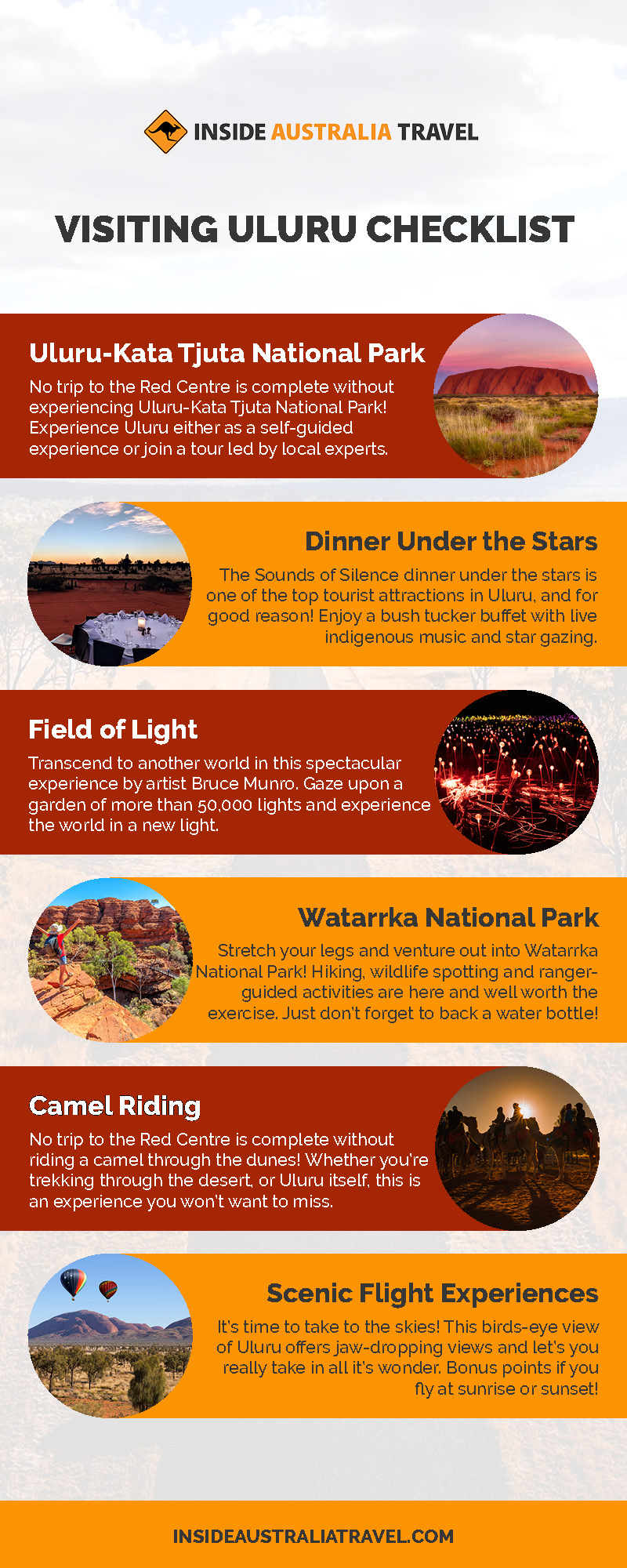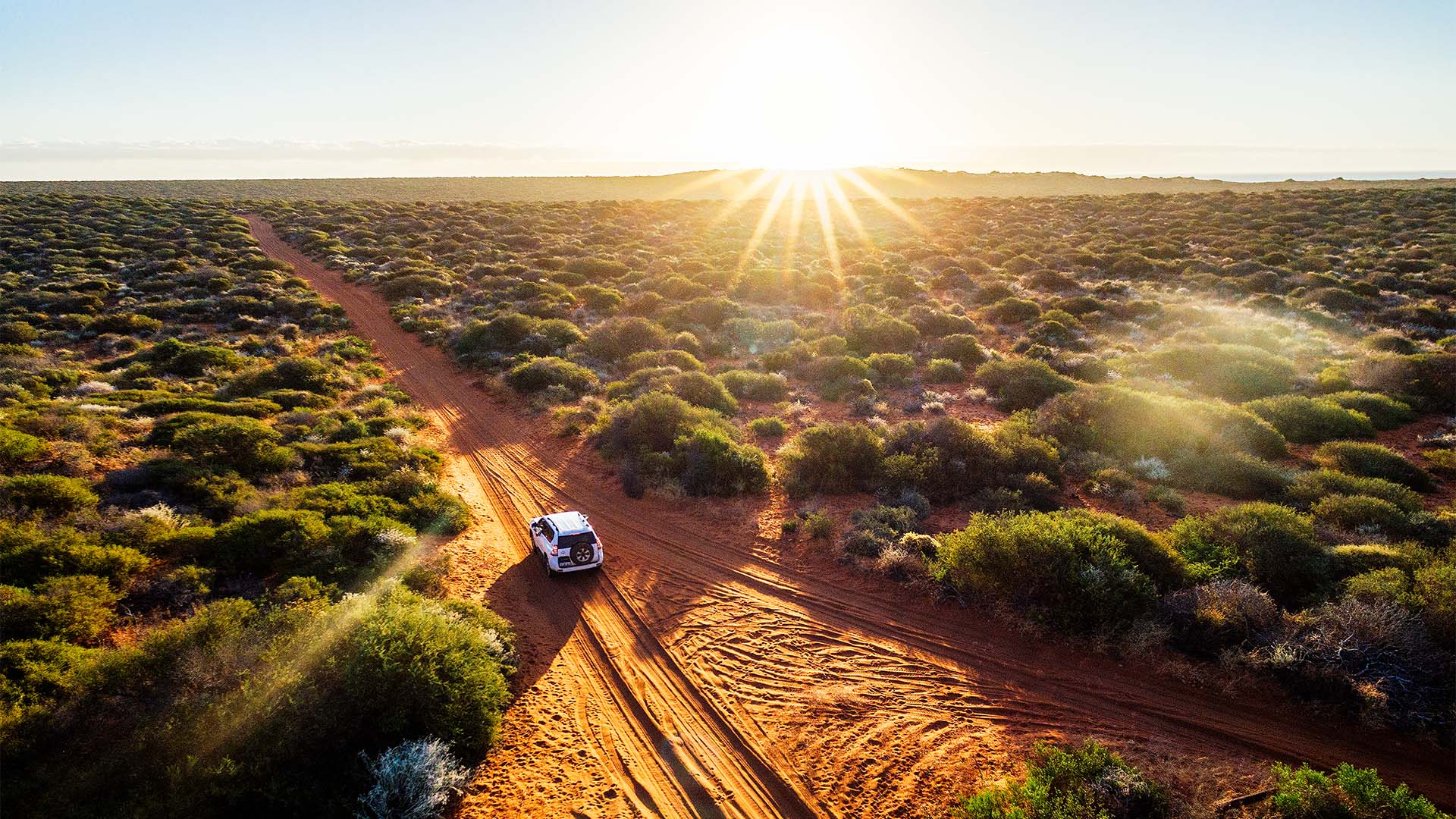Browse other blog categories
Ultimate Guide to Visiting Uluru
If you’re looking for somewhere to travel that has breath-taking natural beauty and once-in-a-lifetime adventure opportunities, you should consider Australia’s spiritual heart of Uluru (Formerly Ayers Rock). Whether you venture off to explore the Uluru-Kata Tjuta National Park on your own, or you decide to take advantage of an organised tour, our guide will ensure that you make the most out of your trip to Australia’s captivating Red Centre.
When is the best time of year to visit Uluru?
First things first, you’re probably wondering 'when should I visit Uluru? Our advice is to head to the region during the months of April through September when the temperatures are milder, as December through March can become rather hot and unpleasant if you’re not used to arid climates. The winter months of June through September are quite mild during the day, but can become chilly in the evenings – if you’re planning on travelling to Uluru during these months, remember to pack some warmer clothes and a jacket.
- Insider Tip: If you head to Uluru from January through March you might be lucky enough to catch a glimpse of the elusive waterfalls that cascade down the sandstone monolith during exceptionally rare rainy days. Only about one percent of visitors get to see Uluru in this way, so if you don’t mind getting a little wet then it’s worth heading out with an umbrella to watch this spectacular natural phenomenon. Just make sure you're prepared for some potential very hot days when it doesn't rain!
What to see
There are tons of not-to-miss sights when visiting Uluru – here’s a breakdown of our absolute favourites:

You can find more information about our favourites below:
- The Cultural Centre: We recommend hitting up the Cultural Centre as your first order of business when visiting Uluru. There are a variety of free displays, presentations, Aboriginal art galleries, shops, and a visitor information desk to help you get your bearings of the park and learn about Anangu culture at the same time.
- Sunrise and sunset: Uluru has become well-known as one of the world’s best places to watch gorgeous sunrises and sunsets. This is one of our favourite things to do at Uluru because at these times of the day the rock formations appear to magically change colour, making for an absolutely unforgettable sight! There are five designated areas in the park to catch the best views (and pics!).
- Kata Tjuta: Also known as The Olgas, Kata Tjuta is a group of 36 large, domed rock formations, which provide yet another spectacular backdrop for sunsets within the park. Thought to be over 500 million years old, the Kata Tjuta is an incredibly significant and spiritual site for the Anangu people.
- Dinner under the stars: Entering its 25th year, the four-hour Sounds of Silence Dinner under the stars remains among the top tourist attractions in Uluru-Kata Tjuta National Park. Fill up on a three-course bush tucker-inspired buffet set to traditional live didgeridoo music under the immeasurable twinkling stars of the Milky Way. After dinner, settle back and turn your gaze upwards while you listen to the resident star-talker decode the southern night sky.
- Field of Light: Book a tour to explore the critically acclaimed Field of Light installation by artist Bruce Munro. The exhibit, called Tili Wiru Tjuta Nyakutjaku (or “looking at lots of beautiful lights”), covers a space the size of seven football fields and includes a fantasy garden of more than 50,000 spindles of light.
Other activities
Need some more suggestions on how to fill your time in the park? We’ve got you covered:
- Bike ride around the park: It’s easy to rent a bike from Outback Cycling. Their shop is located just outside the Cultural Centre. You can usually hire a bike from sunrise until late afternoon (just check for specific times, since these vary depending on the season). Then hop on your bike and go on a self-guided adventure around the scenic 10 km loop of the Uluru landmark. (Please note that some sections of the Uluru Base Walk may be closed for safety reasons during days with extreme temperatures – shorter rides are still permitted on these days).
- Camel ride: For a completely unique experience, consider exploring the park by camel! Uluru Camel Tours offers camel rides that can take you around the park for about an hour and a half. There are also specific rides available at sunrise and again at sunset that last about two and a half hours and offer dazzling views of the natural beauty and wildlife found in Uluru. For a truly authentic Australian experience, some tours include tasty treats such as Australian beer and samples of traditional bush tucker.
- Scenic helicopter flights: For the more adventurous travellers out there, you can jump on a helicopter flight to get a birds-eye view of the park. There are a variety of different flight options to choose from depending on what you want to see. Just make sure that you book ahead (and that you’re not afraid of heights!).
- Watarrka National Park: Watarrka National Park (or Kings Canyon) has many special activities, with everything from bushwalking and wildlife spotting to ranger-guided activities and walking trails. The park itself is a four-hour drive from Uluru, so most visitors either plan a full-day guided tour or spend one to two nights on the grounds. The Kings Canyon Rim walk is a beautiful 6 km loop, which takes roughly three to four hours to complete. It’s the most popular walk within the park, however, there’s also a nice range of shorter, less strenuous walks available.

Other tips you should know
Alice Springs is NOT close by
Contrary to popular belief, Alice Springs is actually a five-and-a-half-hour drive from Uluru-Kata Tjuta National Park – however, this quintessential outback town is still worth exploring. There are a handful of great restaurants in town, as well as plenty of Aboriginal-owned art galleries. If you fancy snuggling an adorable joey (baby kangaroo), the Kangaroo Sanctuary (open Tuesday-Friday) can be visited on a pre-booked guided tour and is our favourite attraction in town. The Desert Park is also worth checking out to get an up-close look at other animal exhibits that feature native Australian wildlife.
Avoid the crowds
For a true outback adventure with a local, hit the road for a few nights on a 4WD safari. Pack a swag and sleep under the stars (tents are optional), tuck into delicious campfire dinners, toast marshmallows and bask in the immense beauty of the great outdoors. As these trips require at least one overnight stay, they tend to be a lot quieter, allowing visitors a chance to truly relax in a state of peaceful tranquillity.
Begin your journey to the Red Centre
Our Travel Specialists here at Inside Australia Travel have all the knowledge and resources to make your Australian journey unforgettable. Contact us for a tailor-made travel plan. Want some more Uluru travel inspiration? Check out our Australian Travel Guide to see more about the types of experiences and tours you can do in Australia.
Categories:
- Cultural Experiences
- Adventure Travel
- Walking, Hiking & Biking
- National Parks & Wildlife
Published on: 17 Feb 2023, Written by: Eniko Simon